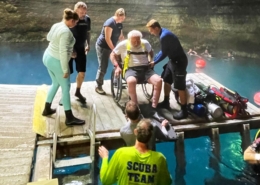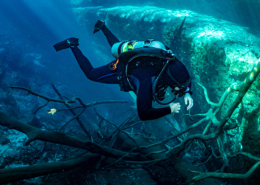Loving your Local Diving
By Gemma Smith
For many of us, scuba diving is simply a holiday activity. It is something we do on a trip abroad each year. We relish the warm water and beautiful marine life in our most commonly chosen destinations. However, not many of us are lucky enough to live in these exotic locations full time. Because of this we probably don’t dive nearly as much as we would like to. What would happen though if we learned to love and appreciate our own ‘backyard’ diving? There is so much wonder waiting on most people’s doorsteps if we only looked. Not many people think of the UK as a hotspot for diving. This is the place I learned to dive over a decade ago. More importantly, this is where I learned to really love my diving, in all conditions and environments.
Whether under a shallow pier, diving on deep sea wrecks, or even just having a play in one of the many flooded quarries, I consider myself lucky to have begun my diving journey submerging in various locations around this beautiful island. I think it’s so important that we as divers learn to love and embrace our own local diving. Not only are there amazing dives to be had, but diving locally is also a great way to keep skills fresh year round. Being current with equipment and good diving practice is so important as a diver. It’s hard if not impossible to maintain currency when only diving on holiday a couple of times a year. Add to that the chance to connect and meet other local divers. This will really help grow a vibrant local diving community. One of the many benefits of being a diver is the social side of the sport. After all, in the grand scheme of a day out diving, relatively little time is actually spent underwater! A local and active dive group is a win-win situation. So in honour of local diving everywhere, here are some of my favourite UK sites to whet your appetite. Hopefully, this will inspire you to go out and explore your own diving neighbourhood. Discover what else may be on your own collective underwater doorsteps. So go on, get out there and dive!
Swanage Pier
This place really holds a special place in my heart. Never going deeper than 4m/20ft, this is a haven for marine life. Exploring between the old pier legs of a past time, there is always so much to discover. It is common during the summer months to see everything covered with marine life. From sponges, sea squirts, and various soft corals, to squid, iridescent cuttlefish, spiny lobsters, crabs, and perhaps even the striking John Dory fish. It is a never-ending underwater wonderland. This is just a small sample of what you might see on a single dive. Due to the shallow depth it is easy to spend many a happy hour exploring the wonders found here. Single tank, doubles, or even CCR, whatever your tool of choice you will be ready for anything. Another great benefit is this site is normally perfect to dive year round, and at all tide levels. Whether a beginner diver or a seasoned pro, diving rarely gets better than this.
Lundy Island
If its underwater puppies you crave, then look no further than Lundy island. Off the coast of North Devon, Lundy is the largest island in the Bristol Channel. As far back as 1986 it was designated the first statutory Marine Nature Reserve. In 2010 Lundy was also made the first Marine Conservation Zone in Britain. And for good reason. The waters here are without doubt some of the richest and most diverse found anywhere on the planet. Stunning coral encrusted wrecks and a plethora of marine life is in abundance here. Without doubt the stars of the show are the resident grey seal colony. I don’t think I have ever laughed so much underwater as I have when diving with these curious and playful animals. Whether it’s a stray tug on a fin or a curious fly-by, these seals are truly magical. It is important to remember that they are wild animals and be suitably cautious and courteous. Never chase or harass them. You will usually find though that they are equally intrigued with you as you are with them!
Scapa Flow
For the wreck enthusiasts out there, Scapa Flow is a must-dive location. Located in the waters of the Orkney islands lies a scuttled German fleet. The history surrounding these wrecks is as fascinating as the wrecks themselves. At the end of World War I the captured German High Seas ships and their crew were interned in the Flow. However, Germany feared the coming peace deal would fall through. To that end the officer in charge, Rear Admiral Ludwig von Reuter, decided to purposely sink all ships. He wanted to stop them falling into use by the British. On 19th June 1919 a total of 52 ships from the German fleet were sent to the bottom of the sea. Even today this remains the greatest loss of shipping ever recorded in a single 24 hour period. Many of these wrecks were later heavily salvaged. However much still remains. From the grandeur of the battleships to the marine life found here (dolphins and orca are not uncommon), this has to be one of the top ten dive sites in the world, let alone the UK.
NDAC
Some might consider this a somewhat unusual choice for a top UK dive site, but I would have to disagree. The National Diving and Activity Center is found in Gloucestershire, close to the Welsh border. A former limestone quarry now filled with fresh water, it is a hidden diving gem. As a year-round location for diving, and working on skills and drills, it cannot be beaten. Wooden platforms are placed at various locations and depths to ensure a good and safe area for students to practice. With a depth of up to 80m/262ft, it is perfect for all levels and experiences of divers. It also boasts a huge amount of underwater structures to explore. From a submerged diving bell to planes, boats, and even a helicopter, you will never get bored. Visibility is usually great. Even better a cosy and inviting cafe is ready and waiting to provide you with hot drinks and a warming meal after your dives. If you want to dive over the winter, remember your local quarries. There are several of them dotted around the country, from the fun of feeding the huge shoals of roach, perch, and trout at Capernwray, to a real archaeologically important shipwreck located in Stoney Cove. Quarry diving should never be discounted!
Chesil beach
This is definitely one of my favourite shore diving locations in the UK. While getting in and out of the water on the steep pebble beach will definitely get your leg muscles working, as soon as you are in the water it is easily worth all the effort. Masses of kelp drifting slowly to and fro in the water, huge pebbles and scattered pieces of wreckage on the seabed, and the chance for discovering hiding octopi and numerous other species of fish nestled among the rocks. In the warmer months, shoals of triggerfish are regularly seen. Even better is night diving here. Some of my best dives have happened on summer evenings. Being surrounded by a mass of glowing cuttlefish still sticks in my mind as one of my most memorable ever diving experiences. No two dives here will ever be the same. It’s a site that can generally be dived in any month and at any tide level. For those people looking for a cheap and easy day of diving, I can’t say enough good things about this site.
This is just a small selection of some of the many dive sites which I am lucky enough to have in my backyard. It’s surprising how many great local diving spots are actually out there when you start exploring. Learning to love the diving in your area is one of the most fulfilling things you can do as a diver. Seeing the effects of the changing seasons and weather patterns on a well-loved dive site is fascinating. The underwater world is constantly changing and evolving. You will be amazed by what you can still discover even at your regularly visited dive spots. Diving locally is also a brilliant way to stay active underwater all year. Besides, who wants to stay land bound too often, when your local waters await you!? So I for one intend to take full advantage of all the magic my neighbourhood diving has to offer. I fully encourage you all to do the same!










Hinterlasse einen Kommentar
An der Diskussion beteiligen?Hinterlasse uns deinen Kommentar!